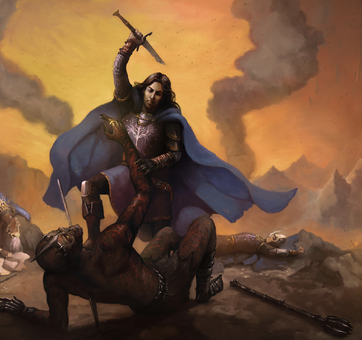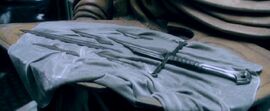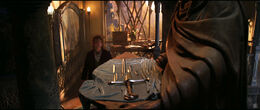Bitterhand (talk | contribs) (Undo revision 270511 by Gondorian2012 (talk)) Tag: Undo |
HiddenValeBot (talk | contribs) m (→In adaptations: Changes, replaced: Portrayal in adaptations == → In adaptations ==) |
||
| (12 intermediate revisions by 6 users not shown) | |||
| Line 1: | Line 1: | ||
{{Object infobox |
{{Object infobox |
||
| − | |othername="Sword That Was Broken |
+ | |othername="Sword That Was Broken" |
|image= Narsil.gif |
|image= Narsil.gif |
||
| − | |manufacturer= [[Telchar]] of [[Nogrod]]<ref name=goldenhall>''[[The Lord of the Rings]], [[The Two Towers]]'', Book Three, Chapter VI: "[[The King of the Golden Hall]]"</ref> |
+ | |manufacturer= [[Telchar]] of [[Nogrod]]<ref name=goldenhall>''[[The Lord of the Rings]], [[The Two Towers (novel)|The Two Towers]]'', Book Three, Chapter VI: "[[The King of the Golden Hall]]"</ref> |
|made= |
|made= |
||
|usage= For fighting, later heirloom of the [[House of Elros]]<ref name=thirdage>''[[The Silmarillion]], [[Of the Rings of Power and the Third Age]]''</ref> |
|usage= For fighting, later heirloom of the [[House of Elros]]<ref name=thirdage>''[[The Silmarillion]], [[Of the Rings of Power and the Third Age]]''</ref> |
||
| − | |owners= [[Kings of Númenor]], [[Lords of Andúnië]], [[Elendil]], [[Kings of Arnor]], [[Kings of Arthedain]], [[Chieftains of the Dúnedain]] |
+ | |owners= [[Kings of Númenor]], [[Lords of Andúnië]], [[Elendil]], [[Kings of Arnor|High Kings of Arnor]], [[King of Arthedain|Kings of Arthedain]], [[Chieftains of the Dúnedain]], [[Aragorn II Elessar]] |
|books= |
|books= |
||
|films= |
|films= |
||
|name = Narsil}} |
|name = Narsil}} |
||
| − | '''Narsil''' was a longsword wielded by King [[Elendil]] during the [[War of the Last Alliance]], and used by his son, [[Isildur]], to cut the [[One Ring]] from [[Sauron]]'s hand during the |
+ | '''Narsil''' was a longsword wielded by King [[Elendil]] during the [[War of the Last Alliance]], and used by his son, [[Isildur]], to cut the [[One Ring]] from [[Sauron]]'s hand during the final battle of that war, being shattered in the process. It consequently was known as the '''Sword that was Broken'''. |
| + | It was later reforged into '''[[Andúril]]''', and would become the sword of [[Aragorn II Elessar]]. |
||
== History == |
== History == |
||
The sword was forged during the [[First Age]] by the famed Dwarven-smith [[Telchar]] of [[Nogrod]]; its knife mate was [[Angrist]]. |
The sword was forged during the [[First Age]] by the famed Dwarven-smith [[Telchar]] of [[Nogrod]]; its knife mate was [[Angrist]]. |
||
=== Second Age === |
=== Second Age === |
||
| + | The sword was presumably taken to [[Númenor]], where it eventually became the property of the [[Lords of Andúnië]]. Nothing is known of Narsil's owners in this time, save that the sword eventually passed to Elendil of [[Andúnië]]. |
||
| ⚫ | |||
| ⚫ | |||
| ⚫ | |||
| ⚫ | During the final battle between the [[Last Alliance of Elves and Men|Last Alliance]] and [[Mordor]], Narsil broke into two pieces when Elendil and [[Gil-galad]] fought Sauron themselves and were slain. Taking up the handle-shard of Narsil after his father's defeat, [[Isildur]] cut the [[One Ring]] from Sauron's hand, defeating him. |
||
| + | [[File:Isildur and Sauron, R D.png|left|thumb|362x362px|Isildur taking the One Ring, after [[Elendil|his father]] and Gil-galad are slain - by [[Ralph Damiani]]]] |
||
Isildur took the shards home with him. Shortly before he was killed in the second year of the [[Third Age]] in the [[Disaster of the Gladden Fields]], Isildur gave the shards to his squire [[Ohtar]] and commanded him to escape if he could. Ohtar did so and took the shards to [[Rivendell]], where they passed to the next king, Isildur's son, [[Valandil]].<ref name="thirdage" /> |
Isildur took the shards home with him. Shortly before he was killed in the second year of the [[Third Age]] in the [[Disaster of the Gladden Fields]], Isildur gave the shards to his squire [[Ohtar]] and commanded him to escape if he could. Ohtar did so and took the shards to [[Rivendell]], where they passed to the next king, Isildur's son, [[Valandil]].<ref name="thirdage" /> |
||
=== Third Age === |
=== Third Age === |
||
| − | The shards of Narsil were passed down as an heirloom by the heirs of Isildur among the Dúnedain of the North. The sword's last owner was [[Aragorn II Elessar|Aragorn]], son of [[Arathorn II|Arathorn]].<ref>''[[The Lord of the Rings]], [[The Fellowship of the Ring]]'', Book Two, Chapter II: "[[The Council of Elrond (chapter)|The Council of Elrond]]"</ref> |
+ | The shards of Narsil were passed down as an heirloom by the heirs of Isildur among the [[Dúnedain of Arnor|Dúnedain of the North]]. The sword's last owner was [[Aragorn II Elessar|Aragorn]], son of [[Arathorn II|Arathorn]].<ref>''[[The Lord of the Rings]], [[The Fellowship of the Ring (novel)|The Fellowship of the Ring]]'', Book Two, Chapter II: "[[The Council of Elrond (chapter)|The Council of Elrond]]"</ref> |
==== War of the Ring ==== |
==== War of the Ring ==== |
||
| − | Before the [[Fellowship of the Ring]] departed [[Rivendell]] on the [[Quest of the Ring]], the shards of Narsil were re-forged by the [[Elves]] into [[Andúril]], which Aragorn carried into the |
+ | Before the [[Fellowship of the Ring (group)|Fellowship of the Ring]] departed [[Rivendell]] on the [[Quest of the Ring]], the shards of Narsil were re-forged by the [[Elves]] into [[Andúril]], which Aragorn carried into the [[Battle of the Pelennor Fields]] and the [[Battle of the Black Gate]]. |
== Etymology == |
== Etymology == |
||
| − | In [[Quenya]], ''Narsil'' means "Red and white flame", from ''nár'' ("fire) and ''thil'' ("white flame").<ref>''[[The History of Middle-earth]]'', Vol. |
+ | In [[Quenya]], ''Narsil'' means "Red and white flame", from ''nár'' ("fire) and ''thil'' ("white flame").<ref>''[[The History of Middle-earth]]'', Vol. V: ''[[The Lost Road and Other Writings]]'', Part Three: "The Etymologies"</ref> It symbolizes the [[Sun]] and [[Moon]], the "chief heavenly lights, as enemies of darkness".<ref>''[[The Letters of J. R. R. Tolkien]]'', 347 To Richard Jeffery</ref> |
== Other versions of the legendarium == |
== Other versions of the legendarium == |
||
| − | In other writings, Narsil was named ''Branding'', after it was reforged into Andúril.<ref>''[[The History of Middle-earth]]'', Vol. |
+ | In other writings, Narsil was named ''Branding'', after it was reforged into Andúril.<ref>''[[The History of Middle-earth]]'', Vol. VIII: ''[[The War of the Ring (book)|The War of the Ring]]'', Part Three: Minas Tirith, IX: "The Battle of the Pelennor Fields", Notes</ref> |
| − | == |
+ | == In adaptations == |
| − | === Ralph Bakshi's The Lord of the Rings === |
+ | === Ralph Bakshi's ''The Lord of the Rings'' === |
| − | In the ''[[The Lord of the Rings (1978 film)]]'' by [[Ralph Bakshi]], Aragorn uses the sword, which still has the longer part of the blade attached to the hilt, as his primary weapon, before it is reforged. |
+ | In the ''[[The Lord of the Rings (1978 film)|The Lord of the Rings]]'' [[The Lord of the Rings (1978 film)|(1978 film)]] by [[Ralph Bakshi]], Aragorn uses the sword, which still has the longer part of the blade attached to the hilt, as his primary weapon, before it is reforged. |
| − | === The Lord of the Rings film trilogy === |
+ | === ''The Lord of the Rings'' film trilogy === |
[[File:Sword_narsil.jpg|thumb|270px|The shards of Narsil on display in Rivendell]] |
[[File:Sword_narsil.jpg|thumb|270px|The shards of Narsil on display in Rivendell]] |
||
| − | In |
+ | In [[The Lord of the Rings film trilogy|''The Lord of the Rings'' film trilogy]] directed by [[Peter Jackson]], Narsil was not broken in two but into several parts (which were kept at Rivendell), and is not reforged into Andúril until the [[The Lord of the Rings: The Return of the King (film)|third film]]. Aragorn uses an ordinary sword during the first two films. Prior to the third film, his attitude towards the sword is a mix of reverence and reluctance. On the one hand, he carefully replaces the hilt on its pedestal after [[Boromir]] carelessly lets it drop to the floor, but he is reluctant to claim possession of it, as it represents the kingship of [[Gondor]]. It is not until the third film that [[Arwen]] persuades [[Elrond]] to have the sword re-forged by the [[Elves]], and Elrond in turn persuades Aragorn to accept it, as the symbol of kingship with which he can command obedience from the [[Dead Men of Dunharrow|Army of the Dead]]. |
| − | [[File:Bilbo_narsil.jpg|thumb|260px|[[Bilbo]] coming upon the shards while in Rivendell]] |
+ | [[File:Bilbo_narsil.jpg|thumb|260px|[[Bilbo Baggins|Bilbo]] coming upon the shards while in Rivendell]] |
| − | In a scene from the extended version (which also appears in the book), Aragorn challenges Sauron by contacting him via the [[ |
+ | In a scene from the [[The Lord of the Rings Extended Edition|extended version]] (which also appears in the book), Aragorn challenges Sauron by contacting him via the [[Palantíri|palantír]] of [[Orthanc]] and showing him "the sword of Elendil" re-forged. |
Comedian [[Stephen Colbert]] owns the sword model used for [[Andúril]] as seen used by Aragorn. |
Comedian [[Stephen Colbert]] owns the sword model used for [[Andúril]] as seen used by Aragorn. |
||
| Line 56: | Line 59: | ||
=== The Hobbit film trilogy === |
=== The Hobbit film trilogy === |
||
| − | Narsil briefly appears in ''[[The Hobbit: An Unexpected Journey]]'' Extended Edition. |
+ | Narsil briefly appears in ''[[The Hobbit: An Unexpected Journey]]'' [[The Hobbit Extended Edition|Extended Edition]]. |
==Translations== |
==Translations== |
||
| − | <div style="overflow:auto; height:300px; width:500px; float:left"> |
||
<!--<div style="overflow:auto; height:200px;">--> |
<!--<div style="overflow:auto; height:200px;">--> |
||
| + | {|class="mw-collapsible mw-collapsed" data-expandtext="Show" data-collapsetext="Hide" style="border: 1px solid #a6a6a6; width:100%; margin: 1em auto 1em auto;" |
||
| − | {| class="itemtable" style="color:#6f3d0b; border:2px solid #FFF; border-top: 0; text-align:left; -moz-border-radius-bottomleft:8px; -moz-border-radius-bottomright:8px; -webkit-border-bottom-left-radius:8px; -webkit-border-bottom-right-radius:8px;" bgcolor="#edeeff" |
||
| width="300" |'''Foreign Language''' |
| width="300" |'''Foreign Language''' |
||
| width="300" |'''Translated name''' |
| width="300" |'''Translated name''' |
||
Latest revision as of 02:57, 26 March 2024
Narsil was a longsword wielded by King Elendil during the War of the Last Alliance, and used by his son, Isildur, to cut the One Ring from Sauron's hand during the final battle of that war, being shattered in the process. It consequently was known as the Sword that was Broken.
It was later reforged into Andúril, and would become the sword of Aragorn II Elessar.
History
The sword was forged during the First Age by the famed Dwarven-smith Telchar of Nogrod; its knife mate was Angrist.
Second Age
The sword was presumably taken to Númenor, where it eventually became the property of the Lords of Andúnië. Nothing is known of Narsil's owners in this time, save that the sword eventually passed to Elendil of Andúnië.
War of the Last Alliance
During the final battle between the Last Alliance and Mordor, Narsil broke into two pieces when Elendil and Gil-galad fought Sauron themselves and were slain. Taking up the handle-shard of Narsil after his father's defeat, Isildur cut the One Ring from Sauron's hand, defeating him.

Isildur taking the One Ring, after his father and Gil-galad are slain - by Ralph Damiani
Isildur took the shards home with him. Shortly before he was killed in the second year of the Third Age in the Disaster of the Gladden Fields, Isildur gave the shards to his squire Ohtar and commanded him to escape if he could. Ohtar did so and took the shards to Rivendell, where they passed to the next king, Isildur's son, Valandil.[2]
Third Age
The shards of Narsil were passed down as an heirloom by the heirs of Isildur among the Dúnedain of the North. The sword's last owner was Aragorn, son of Arathorn.[3]
War of the Ring
Before the Fellowship of the Ring departed Rivendell on the Quest of the Ring, the shards of Narsil were re-forged by the Elves into Andúril, which Aragorn carried into the Battle of the Pelennor Fields and the Battle of the Black Gate.
Etymology
In Quenya, Narsil means "Red and white flame", from nár ("fire) and thil ("white flame").[4] It symbolizes the Sun and Moon, the "chief heavenly lights, as enemies of darkness".[5]
Other versions of the legendarium
In other writings, Narsil was named Branding, after it was reforged into Andúril.[6]
In adaptations
Ralph Bakshi's The Lord of the Rings
In the The Lord of the Rings (1978 film) by Ralph Bakshi, Aragorn uses the sword, which still has the longer part of the blade attached to the hilt, as his primary weapon, before it is reforged.
The Lord of the Rings film trilogy

The shards of Narsil on display in Rivendell
In The Lord of the Rings film trilogy directed by Peter Jackson, Narsil was not broken in two but into several parts (which were kept at Rivendell), and is not reforged into Andúril until the third film. Aragorn uses an ordinary sword during the first two films. Prior to the third film, his attitude towards the sword is a mix of reverence and reluctance. On the one hand, he carefully replaces the hilt on its pedestal after Boromir carelessly lets it drop to the floor, but he is reluctant to claim possession of it, as it represents the kingship of Gondor. It is not until the third film that Arwen persuades Elrond to have the sword re-forged by the Elves, and Elrond in turn persuades Aragorn to accept it, as the symbol of kingship with which he can command obedience from the Army of the Dead.

Bilbo coming upon the shards while in Rivendell
In a scene from the extended version (which also appears in the book), Aragorn challenges Sauron by contacting him via the palantír of Orthanc and showing him "the sword of Elendil" re-forged.
Comedian Stephen Colbert owns the sword model used for Andúril as seen used by Aragorn.
The Hobbit film trilogy
Narsil briefly appears in The Hobbit: An Unexpected Journey Extended Edition.
Translations
| Foreign Language | Translated name |
| Amharic | ኛርሲል |
| Arabic | نارسيل |
| Armenian | Նարսիլ |
| Belarusian Cyrillic | Нарсіль |
| Bengali | নারশীল |
| Bulgarian Cyrillic | Нарсил |
| Catalan | Nàrsil |
| Chinese (Hong Kong) | 納希爾聖劍 |
| Chinese (Mandarin) | 纳熙尔 |
| Georgian | ნარსილი |
| Greek | Ναρσιλ |
| Gujarati | નરસીલ |
| Hebrew | נארסיל |
| Hindi | णर्सिल |
| Japanese | ナルシール |
| Kazakh | Нарсіл (Cyrillic) ? |
| Korean | 나르실 |
| Kyrgyz Cyrillic | Нарсил |
| Macedonian Cyrillic | Нарсил |
| Marathi | नरसील |
| Mongolian Cyrillic | Нарсил |
| Nepalese | नार्सिल |
| Persian | نارسیل |
| Punjabi | ਨਅਰਸਿਲ |
| Russian | Нарсил |
| Serbian | Нарсил (Cyrillic) Narsil (Latin) |
| Sinhalese | නර්සිල් |
| Tajik Cyrillic | Нарсил |
| Tamil | நர்ஸில் |
| Telugu | నర్సిల్ |
| Ukrainian Cyrillic | Нарсіл |
| Urdu | نآرسال |
| Uzbek | Нарсил (Cyrillic) Narsil (Latin) |
| Yiddish | נאַרסיל |
| Barrow-blades • Sting | |
| Durin's Axe • Orcrist | |
| Grond (battering ram) • Grond (hammer) • Morgul-knife | |
| Aeglos • Anglachel • Anguirel • Angrist • Aranrúth • Belthronding • Dailir • Glamdring • Orcrist • Ringil | |
| Andúril • Dramborleg • Black arrow • Dagmor • Gúthwinë • Gurthang • Herugrim • Narsil • Red Arrow | |
References
- ↑ The Lord of the Rings, The Two Towers, Book Three, Chapter VI: "The King of the Golden Hall"
- ↑ 2.0 2.1 The Silmarillion, Of the Rings of Power and the Third Age
- ↑ The Lord of the Rings, The Fellowship of the Ring, Book Two, Chapter II: "The Council of Elrond"
- ↑ The History of Middle-earth, Vol. V: The Lost Road and Other Writings, Part Three: "The Etymologies"
- ↑ The Letters of J. R. R. Tolkien, 347 To Richard Jeffery
- ↑ The History of Middle-earth, Vol. VIII: The War of the Ring, Part Three: Minas Tirith, IX: "The Battle of the Pelennor Fields", Notes
